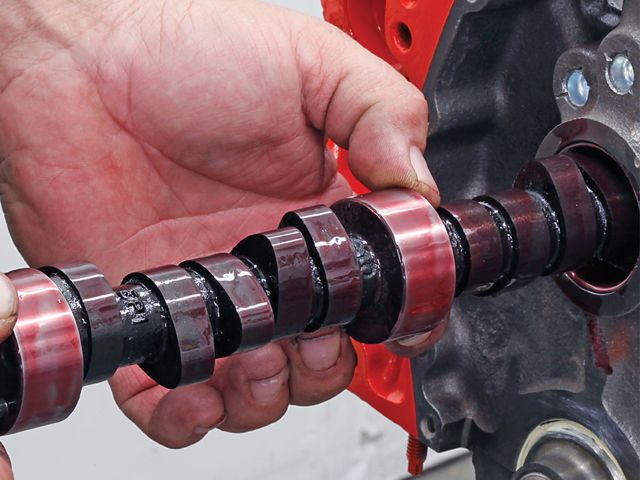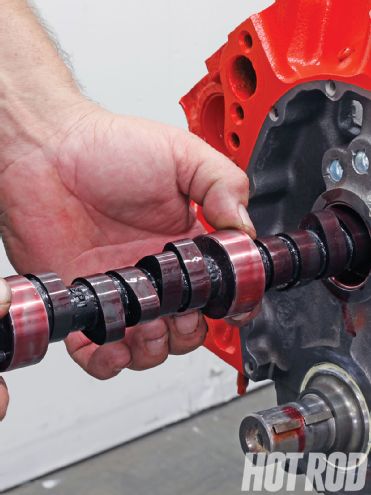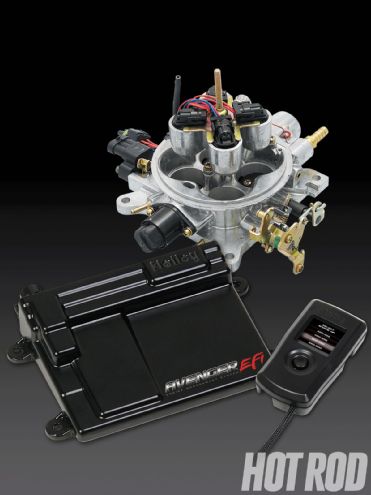
If I use a '96 to '02 truck and van engine (it's a roller motor), can I swap in a roller cam with the same or similar profile as the one you used in last's year's "Cheap 350" buildup (May and June '09), then use this setup in a '96 pickup that has TBI (throttle-body injection) instead of the carb used in the original buildup article? I plan on using an Edelbrock TBI intake instead of a stock one, along with ignition and exhaust upgrades. The goal is to build a strong daily driver on a fairly tight budget.
Charlie Fischer
Edgewater, MD
 Assuming the engine and its management system are capable of supporting it, a roller cam profile should not be a slavish copy of a flat-tappet, but instead optimized to realize the full benefits of the roller-tappet configuration.
Assuming the engine and its management system are capable of supporting it, a roller cam profile should not be a slavish copy of a flat-tappet, but instead optimized to realize the full benefits of the roller-tappet configuration.
Unfortunately, your situation is not ideal due to the late-model fuel-injection system. The cams ground for our carbureted Cheap 350 engine just have too much duration at 0.050 (around 235 degrees intake with 245 to 249 degrees exhaust) and excessively tight lobe separation (107 or 108, depending on the cam). This kills intake manifold vacuum and makes the idle too rough to keep the fuel injection and factory computer happy.
Further complicating the issue for you is the type of fuel-injection system used by GM on the '96 to '99 305 and 350 pickups. Starting in '96 with the introduction of Vortec heads, GM instituted a weird hybrid system known as sequential central port injection, or SCPI. The new system sports a redesigned, big, single-barrel, round throttle body with a different bolt pattern that no longer contains any fuel injectors like the General's earlier pure TBI systems. Instead, a separate fuel meter body assembly was installed behind the throttle body on the upper (plastic half) of the Vortec's two-piece inlet manifold. The new assembly had an integral fuel pressure regulator plus eight centrally mounted injectors firing into eight nylon hoses with downstream poppet valves leading to each intake port. This system was neither pure TBI nor pure direct-port injection.
The original SCPI poppet valves proved problematic. Deposit buildup on the valve's ball and seat would cause the valve to stick open or closed, resulting in a misfueled cylinder and consequent misfire. The problem was usually most apparent under cold start-up conditions after sitting overnight. Initially, GM recommended an injector-cleaning process, but it was only a temporary fix-eventually the problem would recur. According to Burt Chevrolet, GM finally issued a service MFI (multiport flexible injection) kit (PN 93441235) that includes a new fuel meter body, a regulator, eight drivers, eight Multec-2-style injectors, electrical connectors, and lines to connect the drivers in the fuel meter body to the injectors. Also required is a seal kit, upper-to-lower intake (PN 17113206), and a new fuel meter body bracket (PN 93442096). The kit moves the injectors out of the original fuel meter, relocating them downstream in place of the troublesome poppet valves. However, these injectors are still not a standard direct-port fuel injector configuration, so they cannot be upgraded with higher-capacity units. In fact, GM does not even service the injectors separately. Still, the kit does seem to solve the driveability problems seen on some SCPI stockers.
Note that the Edelbrock Performer TBI intake (PN 3704) you want to use fits only original '87 to '95 5.0L/5.7L V-8 cylinder heads and pure TBI setups with the injectors located inside the throttle body. It won't bolt up to Vortec cylinder heads, nor can it accept SCPI parts. GM Performance Parts does offer an intake capable of adopting a classic GM TBI throttle body to Vortec heads (GM PN 12496821), but it still won't accept the SCPI parts. Besides, downgrading your system to an earlier pure TBI setup requires lots of other changes -including a different computer, wiring harness, distributor, ignition coil, fuel pump, and miscellaneous sensors-and isn't worth the effort because you still won't have a system that's versatile enough to make serious power.
In fact, arguably the original pure-TBI setup has less performance flexibility than your SCPI setup upgraded with the previously referenced service fix. Pure TBIs used a MAP (manifold air pressure) sensor that correlated to preprogrammed fuel maps in the computer. At least with SCPI, you have a mass airflow (MAF) sensor that's a little more tolerant of modifications. With SCPI, the limiting factor for performance improvement is more on the fuel and fuel supply end of the system, as opposed to actual metering and calibration.
Keeping all this in mind, with a conventional, MAP-based, pure-TBI system, at least 15 to 16 inches of idle vacuum is needed. In terms of camshaft duration at 0.050, that comes out to only about 196 degrees on the intake side with an 8.5:1-compression-ratio engine, about 210 degrees on a 9 to 9.5:1 engine, and about 216 to 218 degrees at 10 to 10.5:1. The exhaust duration should be about 8 to 10 degrees more, with an overall intake/exhaust lobe-separation angle (LSA) of 113 to 114 degrees. A typical cam for the pure-TBI combo would be Comp Cams' Xtreme Fuel Injection 252XFI HR113 (see table). With the '96 to '00 SCPI or MFI, you can go about 4 to 6 degrees larger than the preceding recommendations, such as Comp's 260XFI HR13 or 268XFI HR13.
 Factory throttle-body injection (TBI) systems won't support cams as radical as those used on our original carbureted Cheap 350 project. In the TBI line, you'll need a system such as FASTS's new self-tuning EZ-EFI setup or the Avenger EFI (shown) coming from Holley in Spring 2010. Holley will also introduce a self-learning port-injection setup.
Factory throttle-body injection (TBI) systems won't support cams as radical as those used on our original carbureted Cheap 350 project. In the TBI line, you'll need a system such as FASTS's new self-tuning EZ-EFI setup or the Avenger EFI (shown) coming from Holley in Spring 2010. Holley will also introduce a self-learning port-injection setup.
Computer recalibration is mandatory with these cams. If going the pure-TBI conversion route, Turbo City is one source for custom computer recalibration and larger throttle body upgrades. Turning up the fuel pressure from the pure-TBI fuel pump's stock 10-to-13-psi setting to 16 to 18 psi via a bigger, pure-TBI-compatible fuel pump is highly recommended. Turbo City can rework SCPI computers as well.
No matter what you do with either setup, even on a perfect day you're probably only looking at 340 to 350 hp. Making 400 hp like we did on the Cheap 350 requires an alternative approach. One solution is to convert the SCPI system to a true direct multiport fuel-injection (MPFI) system with real port injectors attached to fuel rails. The SCPI already uses a high-pressure fuel supply system. In fact, GM installed real port fuel injection on marine versions of the L31 Vortec engines. The marine port-injection intake manifold accepts the stock Vortec throttle body and smog equipment. The throttle body sits in the same place as the stock truck L31 intake, so most aftermarket superchargers and cold-air intakes bolt on. You can keep the stock computer, reflashing it with available aftermarket software. As the late computer also runs the trans, this approach may be preferable to going to a complete aftermarket setup. The Marine swap is discussed in detail on the Pacific Performance Engineering forums. I'd still hold cam durations under the mid-230s with fairly wide lobe separation if using it, though (such as Comp's 280XFI HR13).
Running a hydraulic roller with a narrow LSA and 235/249-degree duration (like Cheap 350's original flat-tappet grinds) mandates either returning to a carburetor or-if you want a relatively simple to use and install EFI system that's tolerant out of the box for traditional hot rod-style cams-consider FAST's new EZ-EFI or Holley's new Avenger EFI, both self-tuning TBI setups that use a big four-barrel throttle body with a Holley flange that's compatible with serious performance intakes like Edelbrock's Performer RPM. See the Dec. '09 issue of HOT ROD for details and tests on the EZ-EFI system.
Those new systems may tolerate a larger-duration, tight LSA cam like the Thumpr hydraulic roller 291THR7 grind. The cam's 0.050 duration is on par with the original flat-tappet setup, but with more valve lift. The ignition will no longer be computer controlled, requiring an older large-cap HEI with conventional centrifugal and vacuum advance. A stand-alone, programmable FAST controller (PN 301002) will be needed for the trans. Obviously, these radical mods won't be emissions-legal.
Click here for the Comp Cams roller cam selection chart